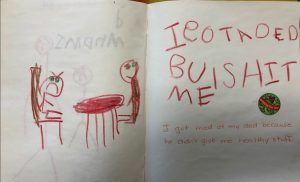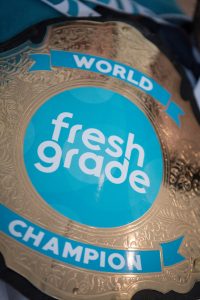
“Old School” by Taryn Domingos is licensed under CC BY-NC-ND 2.0
As I made my way through the readings this week, I detected a theme in my thinking; “Not in my school.” I believe our district would like us to pick up the torch for educational technology but there has been a lack of specific training so our progress has been slow, mostly driven by a few keen individuals. This could be due to the necessity of implementing other priorities such as BC’s new curriculum. We have had numerous sessions to get us to understand Core Competencies and Inquiry-Based Learning.
The district has been keen to get us to use FreshGrade for reporting for about four or five years so they offered training on our own time; I first tried out the program in 2016 but I had no wi-fi access inside my classroom until 2018. If I wanted to upload something, I had to leave my classroom and find a sweet spot in the hall. The wi-fi itself was a long time coming, in part, because our parent community resisted, thinking wi-fi could affect brain development. Where did the research on that end up, anyway?
We were offered two beginner training sessions for GSuite a couple years ago but it was on our own time and not attended by all. I still have the odd staff member who comes to me for help to open a Google Doc. Our IT department has repeatedly asked staff to store more files on Google Drive instead of the local network. Our new-this-year, younger, administration team is keen to have us use Google for staff collaboration and I believe the intermediate classes have given their students Google accounts but I don’t think every intermediate class uses them. Still, I guess we can say that the cloud computing trend is hitting here.
With the help of the Parent Advisory Council (PAC), we have worked our way up to two class sets of iPads and a class set of Chromebooks shared by about 340 elementary students. We still have a computer lab with desktop computers; I’m not sure if that’s a good thing or a bad thing. Lahullier (2018) mentioned a trend toward 1:1 devices. If he meant everyone in the class would have access to a device for 30 minutes a week, then we are there! To be honest, I would be happy with three or four iPads in my room at all times for small group sessions. I cannot manage 20 Kindergarten children, each with a device!
Now that we have iPads and wi-fi, apps such as iMovie, Draw and Tell, GreenScreen, PicCollage, and ChatterPix have become popular with a few keen teachers and our teacher-librarian. I think the only game apps we have are Reflex Math, Scratch Jr., and Farm Phonics so we are behind a bit on the gamification trend mentioned by Lahullier (2018), Lambda Solutions (2019), and Holland & Holland (2014). This is likely because the best games cost money. Our iPads are controlled at the district level so apps must be requested.
We could say we are working on the coding trend. We have that Scratch Jr. app, and last year the teacher-librarian convinced the school to purchase a dozen Spheros and a BeeBot. I think they have been used about a dozen times, mostly in June.
When I read 2019 EdTech Trends You Should Be Excited About (Jarman , 2019), I laughed out loud. Our PAC purchased a Smartboard for the school I don’t know how many years ago (before I arrived); no one knew how to use it and there was no training so, to my knowledge, it has never been used and I’m told it no longer works. But Jarman is hopeful that the prices are dropping so maybe some day.
I would like to get excited about augmented and virtual reality but I can’t help thinking we should leave something for the higher grades. Holland & Holland cited authors Trucano, Hawkins, and Iglesias (2012) with a trend they called “earlier and earlier”. I agree many technology pieces can and should start as early as Kindergarten but the littles are still excited about learning in their own neighbourhood and getting their hands dirty. Why not leave voyages to space or the depths of the ocean to the older learners? As for Global Learning, that’s a tough concept for children who are still learning that they live on Vancouver Island and Grandma lives in Vancouver.
Holland & Holland talked about “Shifting Technologies” and “Instructional Gaps” (2014, p. 16). The debate about handwriting is an interesting one. Maybe people do not need to learn cursive writing; perhaps it will become part of the visual arts curriculum or history (so people can read historical documents). Surely, no one is suggesting children should not learn to print by hand. How would they play Hangman when the power goes out? I think it’s always going to be a good idea to put a pencil in the hand of a child. “Kid writing” is one of the

T. Westwood
most exciting parts of their development! It is also an important part of developing fine motor skills. It’s already challenging explaining concepts of money to 5 year olds without pennies; it’s going to be crazy when there is no cash at all! For elementary school aged kids, there needs to be a balance between basics and technology.
In kindergarten, our big focuses are social/emotional learning, self-regulation, and growth mindset. They need to play and explore real life and real people but no one can deny that digital technology is engaging for them. For the littles, the trend is the blend. Create something and then document it with video or audio. Create something on a device and then talk about it in front of someone. Capture something happening in the classroom on video, show it to them, and record their thoughts about it. Take an iPad outside to explore and record thinking about the big and the small, the sky, the trees, the spider webs, and the ladybugs. I will soon be blending classroom citizenship with digital citizenship. We talk about being kind to each other, their art as intellectual property, and their bodies as their own so it makes sense to talk about saying nice things online, asking permission to post their art, who is allowed to take their picture and so on.
As for teachers, Jobanputra (2018), Jarmin (2019), and Holland & Holland (2014) all mention a trend in Learning Analytics. I have some more work to do around understanding this topic but if I get the gist, I think the closest we get in BC elementary school is The Foundation Skills Assessment (FSA) and FreshGrade. The FSA is far from predictive and does nothing in terms of guiding plans for individual learners. There is a grading and tracking component that goes with FreshGrade but I do not really use it; for me, it is more for communicating with and reporting to parents. As a Kindergarten teacher, all my data analysis happens in my brain, not in a computer program.
I have had experience with assistive technologies, such as text-to-speech, in past years and trends that help with inclusion will always be welcomed with enthusiasm. I have a non-verbal student this year who uses an iPad to communicate. I need to learn the capabilities of this tool and the student so I can design lessons that are more universal for the whole class. If this is not a trend, it should be.
Learning about how to use technology in the classroom has been largely up to each individual. Do I agree with the trends identified in this week’s readings? My school seems to be about four years behind but I think most are true. The pricier ones will not make it to public school anytime soon, but the private schools may see them. Maybe they already do.

Leave a Reply